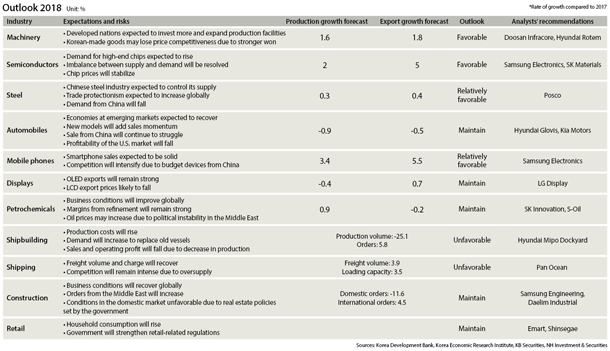The industries that will drive Korea Inc. in 2018

Analysts will say economic conditions are hard to predict, but here, we will do our best. A handful of industries are expected to extend their rally into 2018, some will take a breather and those who struggled through 2017, well, let’s just say they’re going to have to struggle a little longer.
Semiconductors
Korea will likely continue milking this cash cow into 2018.
Last year, the country’s exports reached a record high $573.9 billion, and semiconductors accounted for more than $90 billion. That’s over 15 percent.
As tech giants like Apple, Google and Samsung develop faster, more advanced devices ranging from smartphones to smart speakers, demand for high-end, large-storage memory chips will remain solid, and suppliers are expected to continue rolling in the dough as parts prices rise. World Semiconductor Trade Statistics estimates the market size will grow 7 percent in 2018 to $437.2 billion.
What is difficult to project, though, is exactly how long the super cycle will continue for semiconductor makers. Morgan Stanley forecasts that DRAM and NAND flash memory chips will see a downturn after this year, even as semiconductor investment is on the rise, with China ramping up efforts to produce chips of their own. Lower demand and higher supply means Korean suppliers could be in for a fight.
Automobiles
Korean carmakers had a tough year in 2017 due to a diplomatic row between Beijing and Seoul that hacked at their market share in China, the world’s largest market for cars. Prospects are unlikely to improve in 2018.
The Korea Automobile Manufacturers Association estimates that the global auto market’s growth will slow down from 2 percent last year to 1.9 percent this year, and Korean exports will drop by 1.5 percent in 2018 to 2.57 million cars, the lowest in five years.
Expect a slew of unfavorable conditions this year, including stagnant global demand and greater trade protectionism. In Korea, where the government suspended Audi and Volkswagen sales in late 2016 and all of last year due to their emissions rigging, the German powerhouses are returning to the market this year, adding more competition for local carmakers.
“The Korean auto industry is in a crisis, losing global price competitiveness due to a strong Korean won and decline in production due to worsened management-labor relations,” said Kim Yong-geun, president of the Korea Automobile Manufacturers Association. “The industry is in dire need of policy support to revitalize domestic sales and stabilize exchange rates.”
One speck of good news for Korea Inc. is rising demand from emerging markets like Russia and India.
Petrochemicals and steel
Korean oil refiners, which enjoyed record profit in 2017, will likely take a breather this year.
Refinery margins, which represent profit calculated by subtracting the price of crude oil from petroleum products, will remain strong in 2018 due to rising demand and lack of refinery facilities around the world. Petrochemical demand from India is on a steady rise as its economy continues to experience accelerating growth.
The deal-breaker, though, will be political instability in the Middle East. As conflict between Saudi Arabia and Iran continues, global crude prices will likely rise, further burdening petrochemical companies.
In the steel industry, China, as the biggest producer and consumer, continues to control its supply, meaning better market condition for Korean players like Posco.
Still, there are some risk factors. Industries that require a large quantity of steel such as construction are showing little indication of recovery this year. Concerns about protectionism in steel, particularly from the United States, will exacerbate the risk.
Displays and home appliances
In IT, the Korean display business will remain healthy in 2018, maintaining a similar export level as 2017. The industry is expected to shift away from rigid screens to more flexible organic light-emitting diode, or OLED, material, especially as curved smartphones like the Galaxy series and car dashboard panels require it.
Korean panel producers, though, including LG Display, will have to stay vigilant of competition from China.
In home appliances, protectionist moves from the United States pose the greatest threat, though Korean manufacturers could also face safeguard measures from the Middle East, where countries are trying to foster their own home appliance industries.
Retail and biopharmaceuticals
Along with automakers, Korean retailers were the victims of political tension between Seoul and Beijing in 2017. Fortunately, relations are showing signs of a thaw, signaling the return of Chinese customers. Domestically, Korean households will likely gain more purchasing power this year as economic conditions improve.
Pharmaceuticals should be under the spotlight in 2018 again. Korean companies are expanding their development of biosimilars, drugs designed to have active properties similar to the originals.
BY SOHN HAE-YONG, PARK SU-RYUN [choi.hyungjo@joongang.co.kr]










with the Korea JoongAng Daily
To write comments, please log in to one of the accounts.
Standards Board Policy (0/250자)